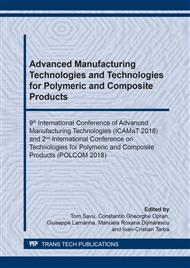p.417
p.427
p.437
p.445
p.455
p.465
p.475
p.483
p.493
Finite Element Modelling of Thermal Behaviour of Solar Cells
Abstract:
Engineering Science Based on Modelling and Simulation (M & S) is defined as the discipline that provides the scientific and mathematical basis for simulation of engineering systems. These systems range from microelectronic devices to automobiles, aircraft, and even oilfield and city infrastructure. In a word, M & S combines knowledge and techniques in the fields of traditional engineering - electrical, mechanical, civil, chemical, aerospace, nuclear, biomedical and materials science - with the knowledge and techniques of fields such as computer science, mathematics and physics, and social sciences. One of the problems that arise during solar cell operation is that of heating them because of permanent solar radiation. Since the layers of which they are made are very small and thick it is almost impossible to experimentally determine the temperature in each layer. In this sense, the finite element method comes and provides a very good prediction and gives results impossible to obtain by other methods. This article models and then simulates the thermal composition of two types of solar cells, one of them having an additional layer of silicon carbide that aims to lower the temperature in the lower layer, where the electronic components stick to degradable materials under the influence of heat.
Info:
Periodical:
Pages:
493-502
Citation:
Online since:
June 2019
Keywords:
Price:
Сopyright:
© 2019 Trans Tech Publications Ltd. All Rights Reserved
Share:
Citation:


